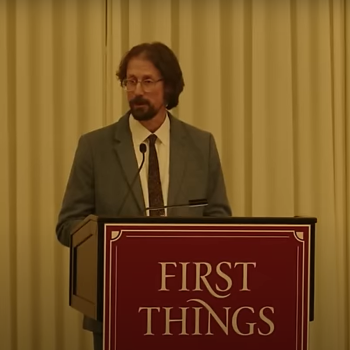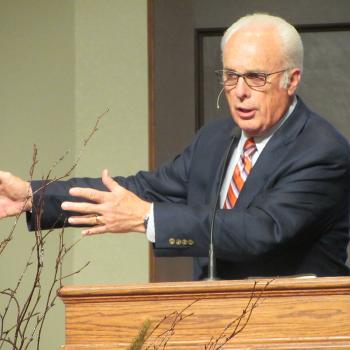
It is 2019, and Western Civilization is having a crisis. Specifically, it is having a crisis of meaning. Suicide rates are rising, even among the wealthy and successful. Young children are questioning their gender. Young men are questioning existence itself. Killers are writing nihilistic manifestos and livestreaming their own crimes. We seem to be a ship unmoored, drifting on a sea of hopelessness and unanswered questions—or worse, questions to which ideologues of all stripes are supplying the worst possible answers.
With The Right Side of History: How Reason and Moral Purpose Made the West Great, Ben Shapiro hopes to speak into this crisis of meaning. Blending history of ideas, philosophy, and up-to-the-minute cultural commentary, he examines both how the West was lost and how it might be recovered. The West was lost when it lost its reason and its moral purpose. The West might be recovered if we return to the places that gave reason and moral purpose their birth: Athens and Jerusalem.
From these twin starting points, Shapiro takes the reader on a whirlwind tour through time. We receive God’s law with Moses at Sinai, contemplate natural law with Plato and Aristotle, and watch the unfolding flower of scientific progress through the alleged “Dark Ages” (which, it turns out, were not so dark). We read the men behind the American and French Revolutions in their own words, observing and understanding how the two streams diverged. We simultaneously taste the first-fruits of Enlightenment thought and learn where the fruit went rotten: It went rotten when Enlightenment thinkers sawed off the branch they had been sitting on all along.
For the West, this took the form of a gradual abandonment of Christianity, which Shapiro views as the great convergence of Athens and Jerusalem. Before their convergence, he contrasts the god of the Greeks with the God of Abraham. The first is a deistic First Cause whose personal investment in the affairs of man is at best vaguely understood. The second frequently dips His pen in history to deliver revelation to His chosen people. Christianity took the idea of a personal God and made it universal. No longer was history the story of God’s romance with a particular people. It was the story of God’s romance with all mankind. Furthermore, as Christian thinkers like Aquinas would argue, we could apprehend something of God’s nature by reason without recourse to special revelation.
It is tempting for Shapiro’s purposes to portray the birth of Christianity as “the first serious attempt to merge Jewish thought with Greek thought.” The writing of the gospels in Greek signals the desire to universalize “the story of Jesus,” who is “conflated” with “the Logos” in John. Paul is seen as a key architect, “morphing” the Jewish belief in a political messiah into the idea of a spiritual messiah.
Unfortunately, this abstract Hegelian synthesis runs aground on the concrete historical reality of how Christianity actually came to be. While the authors of the gospels wrote in Greek, there is no good reason to think they would have been educated in “Greek thought” or crafted “the story of Jesus” as an attempt to weave together Jewish and Greek ideological strands. Luke, the only Gentile author, repeatedly makes it clear throughout his gospel and its sequel, the Book of Acts, that his purposes are descriptive and historical in nature: He wishes to present the facts of the matter as they unfolded, as accurately as he is able. Paul’s radical conversion and subsequent ministry also leave few options open for purposes of historical evaluation.
“Divisive” as it sounds, there’s no gentle way to say it: The reader who makes a careful and impartial study of the New Testament’s provenance must inevitably conclude that it can only be explained as a product of deception, insanity, or reality. Nothing in between will suffice. Shapiro, it seems, has yet to make such a study.
I also can’t let pass the comment that “Christianity, like all religions, focuses on the spiritual to the exclusion of the physical” (p. 71). On the contrary, it is precisely in this realm that Christianity distinguishes itself, particularly from Eastern religions. Our bodies as well as our souls are a product of divine design. Christ’s physical incarnation and death brought redemption to the realm of the earthy and the tangible. That redemption was consummated and sealed by Christ’s physical resurrection, a point on which Christianity’s founders were unanimous and relentlessly insistent. Consequently, it is to the resurrection not only of the soul but of the body that we look in the life of the world to come.
However, despite these disappointments, the book is a welcome corrective to bad history of ideas in other respects, particularly the secular neo-Enlightenment revisionism of thinkers like Steven Pinker. As Christian scholar Nick Spencer also pointed out to Pinker in their Unbelievable? debate, the scientific revolution was not a great casting off of religious superstition. Rather, it was driven by Christians seeking to understand God through nature (a process that began in the monasteries of the “Dark Ages”). Shapiro also points out the remarkable irony that Pinker manages to get through his own book without once mentioning the French Revolution. Like all those who would rip the tree of the West out of the Judeo-Christian soil where it was planted and bid it be fruitful, Pinker appears not to have learned from history. (I confess that whenever I see Pinker waxing thus naively nostalgic, his inescapably wig-like white curls bobbing, I have an overwhelming urge to shout “Excuse me, sir? Sir, the Enlightenment LARP-ing is that way. You might still be able to play Voltaire if you hurry.”)
In this respect, Shapiro echoes Jordan Peterson. Peterson is known to needle New Atheists like Sam Harris by provocatively saying they are “Christian” without knowing it, in the sense that they are unconsciously building their alleged secular replacement frameworks for meaning on the foundation of Judeo-Christian values. For example, Harris’s “moral landscape” is built on the assumption that human well-being should be maximized and human suffering minimized. But Shapiro and Peterson argue that this presupposes the value of the human individual.
From a bird’s-eye perspective, Shapiro wants to argue that he shares some broadly similar goals with Pinker, Harris, et alia, but that he as a theist brings the ontological grounding they lack. In a vague sense, this might be true: All of them generally agree upon the value of truth-seeking, the value of human reason, the affirmation of biological reality in the face of post-modern deconstructionists, and the pursuit of measures that might raise the quality of life for humanity writ large. None of these things can be coherently grounded in a materialistic secular framework.
But in fact, as I have written for The Federalist, Pinker and Harris are really not far removed from logical madmen like Peter Singer when it comes to judging the intrinsic worth of human life. Where Shapiro argues for human exceptionalism and the right to life of all humans by virtue of their humanity, Harris and Pinker regard man as just another animal, whose worth may fluctuate depending on context or stage of development. In this respect, they are fully consistent materialists. From there, it is only a couple of steps to wondering out loud on exactly what moral grounds we still outlaw infanticide.
The looming figure of Charles Darwin cannot be ignored in such discussions, and Shapiro gives him his full due. By proposing randomness as a “unifying field theory of life,” Darwin pulled the rug of telos out from under the West. Design became an illusion. Human exceptionalism became an illusion. Man became an animal, confined to the iron box of nature like all other animals. Reasoning capacity was reduced to the firing of neurons in the brain. Morality and truth were redefined in terms of evolutionary adaptation, no longer grounded in a transcendent, timeless reality. Finally, it was possible to be an intellectually fulfilled atheist. The celebration was riotous, but the bill would come due.
From here Shapiro ably works through the rest of the 19th and 20th centuries. Besides Western Civilization’s inexorable descent into genocidal bloodshed, Shapiro also traces the subtler philosophical influence of Darwinian pragmatists like John Dewey on political figures like Woodrow Wilson. Wilson wrote that the Constitution should be interpreted “according to the Darwinian principle” — pragmatically, progressively. It is here that we see the first seeds of living constitutionalism being planted. (Wilson was also an early advocate of the American eugenics movement, along with other leading lights like Teddy Roosevelt and Oliver Wendell Holmes.) Shapiro’s focus on the West’s decline means that some brighter chapters of our history are passed over, including the Reagan revival of the 80s. Pope John Paul II, Solzhenitsyn, and Margaret Thatcher are some other figures who go unmentioned. Thus, while Shapiro discusses the roots and rise of communism, he does not discuss its fall in the Soviet Union. He covers so much other ground that omissions like these stick out somewhat, but they are understandable.
Continuing to trace the effects of materialistic reductionism, Shapiro spends some time on the work of another famous Wilson, sociobiologist E. O. Wilson. Wilson proposed that free will was illusory and that the behavior of human beings could be perfectly mapped in Darwinian terms. Shapiro’s analysis here has the flavor of C. S. Lewis’s analysis in The Abolition of Man, showing how Wilson fails to leap Hume’s gulf between “is” and “ought.” While Shapiro only mentions evolutionary biologist Bret Weinstein in connection with Evergreen College and the free speech wars, he might have mentioned here that Weinstein is trying to carry forward Wilson’s project in the present day. Like Wilson, Weinstein urges us to “reject” our “programming” and chart a new course. We can no longer dance with the one that brung us. But, as Shapiro asks Wilson, we might ask Weinstein, “Who’s we? Also, what’s with all the active verbs?”
Jordan Peterson is another member of the Intellectual Dark Web whose intellectual project is passed over in this book. In fairness, Peterson’s rise has been so rapid that it is likely Shapiro had finished his draft before anyone had had time to get familiar with Peterson beyond the fracas over Bill C-16. Besides, Shapiro probably rightly gauges that his base will be more interested in Peterson for his connection to the campus wars than for his research. Still, many of the strands of thought Shapiro is exploring have come together in the Peterson phenomenon, including the tension between materialism and religion and the connection between meaning and responsibility. It would have been fascinating to see Shapiro make a stab at unpacking how this devoted pupil of Darwin has single-handedly sparked a revival of interest in the Bible. However, Shapiro does indirectly get at some of the roots of Peterson’s thinking by explaining how pragmatism and Darwinian “truth” go awry. He judges, rightly, that to abandon a correspondence theory of truth is unsustainable. It devours itself. It is on this among other snags that Peterson’s project founders, despite his undeniable influence for good in the midst of the West’s meaning crisis.
The book is rounded off by a recap of our 21st-century return to paganism, as the last remnants of rationality have been cast aside for good. Here Shapiro argues that “the new scientific Athenians” and “the devotees of Jerusalem” can make common cause. On this he is echoed by British thinker Douglas Murray, who once gleefully pointed out to Sam Harris that Harris could count his like-minded allies in the secular academy on the fingers of one hand. To Shapiro’s credit, he does not limit his criticism to the intersectionalist insanity of the left. He also censures the “reverse racial solidarity” of the alt-right, which plays the exact same game of identity politics. Whatever side it comes from, tribalism is not the answer. The meaning it promises is a corrosive substitute for the real thing.
Where, then, can we find the real thing? Not in politics, and not in wealth either. Enlightenment ideas like capitalism are a wonderful thing. But capitalism cannot fill your soul. Instead, in fine Petersonian fashion, Shapiro proposes that meaning is found in sacrifice and responsibility—specifically, the responsibility to train the next generation. We must teach them that life has purpose. We must teach them that they are free to choose, and their choices matter. We must teach them the value of what they have inherited. Finally, we must teach how they might come together for the common cause of liberty and the preservation of virtue. We must teach them to pull in the same direction. Shapiro quotes a wise word from his father that there are not six directions in life, only two: forward and backward. There are those who would force us to turn around and go backward, to a drunken paganism that knows nothing of Jerusalem or Athens, while calling it “progress.” Athwart their path, Shapiro has squarely planted himself, like a diminutive young Tevye, crying “TRADITION!”
It’s a rousing cry, one that lands with weight. It is also strong in places where Jordan Peterson’s rallying cry is weak, undergirded as it is by a firm grasp of the nature of truth and the nature of God.
And yet, something is still missing.
After giving a short history of Western Civilization in 200 pages, Shapiro ends on a surprisingly vulnerable, intimate note: a quiet bedtime moment with his daughter. “Daddy,” she asks, “will you always be my daddy?” Of course he will, he says.
She’s still concerned: “But one day I’ll be older. And really old people die. So will you still be there?”
Then he understands. He pauses to collect himself before stroking her hair reassuringly. Yes, he will be there. Mommy and daddy will always be there.
“While I’m a believer in the afterlife,” he writes, “there’s no real way to know. I don’t know what comes after this. Nobody does.” Outside his daughter’s door, the questions linger. Are we just ants on this pale blue dot? “In the end,” he wonders, “are we all orphans?” Soot-covered urchins, running wild and unshod?
In the end, Shapiro clings to the touchstone of memory. Our parents are always alive—in us. They carried the flame of their ancestors, and we carry it to our descendants. So long lives this, and this gives life to them.
Shapiro probably wasn’t thinking of this, but Billy Joel fan that I am, I couldn’t help thinking of the song “Goodnight, My Angel.” Like Shapiro, Joel recounts that he found himself caught off guard as he tucked his daughter into bed. “Daddy, what happens when you die?” she asked him. Joel’s answer has something of the same flavor: We live on through others. We live on in memory. “Some day we’ll all be gone, but lullabies go on and on. They never die. That’s how you and I will be.”
I hope for both of them something more sure, more certain. I hope the winds of time might yet carry to them the voice of One who stood with arms outstretched to Jerusalem, longing to gather in the children of Abraham, and their children’s children.
My eyes at times can see Him still.













